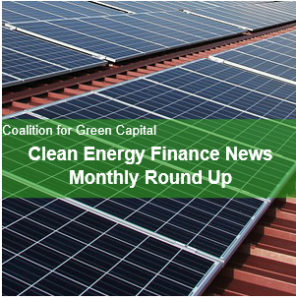
NY Green Bank Closes $37.5M Solar Deal with Vivint
“The loan is structured as a medium-term (five-year) note and allows Vivint Solar to recycle capital that can be used for the installation of new residential solar systems in New York. With this loan, the bank says, Vivint is expected to continue to add to its existing New York projects totaling nearly 58 MW of solar on a total of approximately 8,250 New York homes. These solar systems will add to the more than 50,000 New York homes that have already installed solar, the bank notes.”
R.I. Infrastructure Financing Approved for Energy-Efficiency Projects in 6 Communities
“The Pawtucket projects include installation of LED streetlights throughout the city as well as high-efficiency boilers, energy-efficient windows and lights, and Wi-Fi programmable thermostats in municipal buildings. The $3.9 million in upgrades is expected to save the city’s taxpayers more than $750,000 a year “The Rhode Island Infrastructure Bank is putting Rhode Islanders back to work, strengthening our infrastructure, and reducing our demand for energy by providing a dependable source of capital,” Governor Raimondo said in a statement.”
Green Banks and ‘Big Switch’ to a Low Carbon Future
NRDC is working to support the creation of new public institutions called Green Banks as one way to help mobilize private capital and speed up the big switch. Green banks have been created to partner with the private sector to increase investment in clean energy and help make more clean energy financing mainstream, towards no longer needing public assistance. Green banks often attract private capital by de-risking clean energy projects, such as by co-investing in them or offering credit enhancements, or making the projects easier for big banks to finance, such as by aggregating lots of small projects together and filling other market gaps like marketing and consumer awareness. Which financial and other tools the green banks employ and which technologies they invest in depends on the needs of the local markets in which they are active and on the green bank’s missions.
Wastewater Plant to Be Solarized
Once complete, Newport will have the only wastewater treatment plant in Rhode Island utilizing solar energy. Supporting documentation specifies that the project is expected to be wrapped up by February of 2019. Funding will be through a $1.2 million loan from the Efficient Buildings Fund administered by the Rhode Island Infrastructure Bank and an $896,200 grant from the Clean Water State Revolving Fund.”
What 10 Years of RGGI’s Carbon-Trading Agreement Means for the Future
“The biggest success of RGGI is not a move away from coal, but a solid investment in energy efficiency. Some critics argued the trading prices were so low RGGI could never achieve anything, but that too proved not to be the case. Budgets for energy-efficiency programs in the nine RGGI states grew from $575 million in 2008 to nearly $2 billion in 2015, according to Acadia. That number is expected to continue climbing.”
How Funders are Using the Power of Their Investments to Impact Climate Change
“Given the scale of the challenge and political momentum generated by the Paris Agreement, quite a lot of our portfolio is climate-focused.… We fortunately already have a broad set of proven [technology] solutions that we know to be effective and cost-efficient. The challenge is about finding the right financing solutions or business models to incentivize large-scale investment into them so that they are widely adopted and scaled up.”
Green Up enables borrowers with qualifying properties to increase the amount of their eligible Freddie Mac Multifamily loan by up to 50 percent of projected energy and water savings. Under Green Up Plus(SM), borrowers can increase the loan amount by up to 75 percent of the projected savings. Borrowers who go for the Green Advantage may also get better pricing as an extra incentive to go green. Under Green Up, savings are calculated through a Green Assessment(SM), a short, straightforward evaluation of green opportunities, estimated costs, and projected savings. For Green Up Plus, borrowers must provide a Green Assessment Plus(SM), which is a more detailed analysis, based on an ASHRAE Level 2 assessment, that can potentially lead to greater savings opportunities.